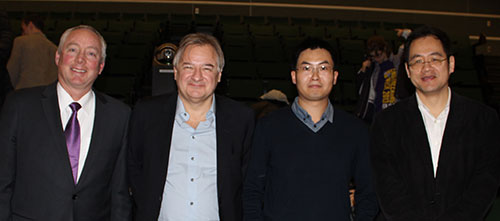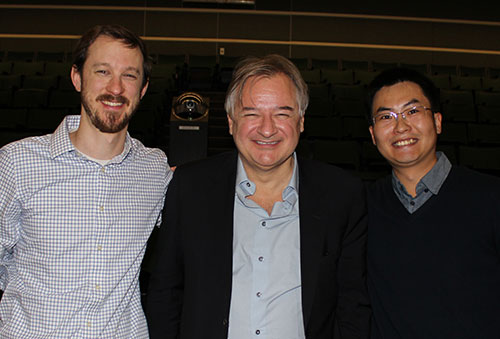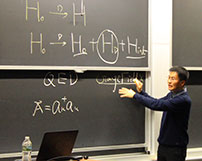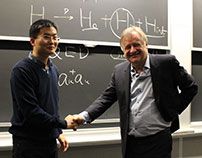Del Favero Lecture: Radiation physics today for materials science tomorrow

L to R: Professor Ju Li, Dr. Mingda Li, James Del Favero, Professor Dennis Whyte
To the naked eye, radiation is a mysterious, invisible energy that permeates space, seemingly unimpeded, until it is either reflected or absorbed by an object. This behavior is precisely what makes radiation an excellent tool for scientists to interrogate and explore the atomic structure of materials. In the 2016 Del Favero Doctoral Thesis Prize Lecture, Dr. Mingda Li, shared his perspective as a nuclear scientist on how radiation can be used to benefit society and help us understand and design new materials.
Radiation has four common roles in society: nuclear treatment (e.g. cancer radiotherapy), energy source (e.g. nuclear power plants), material exploration (e,g, microscopy), and material design (e.g. electron-beam lithography). In his address, Li envisions a picture about how radiation byproducts, such as crystal dislocations, can be utilized to systematically alter material properties in a controllable way.
Li’s research, performed with advisors Prof. Ju Li and Prof. Jagadeesh Moodera, is focused on developing new quantum theory to more accurately model defects in materials. Material defects interrupt the structured lattice of a crystal and, in aggregate, result in the bulk material taking on new properties. These defects can cause either favorable or unfavorable changes to the material properties. As Li described in his lecture, blacksmiths have been inducing defects in to their swords for centuries through a process called work hardening that increases their strength in battle.
Fast-forward to the modern era and scientists like Li are envisioning new ways to precisely alter a material’s properties by inducing defects; Radiation plays a dual role in this process as both a tool for exploration and design. In his work, Li has developed a new quantum theory of dislocation to allow the study of dislocations on materials’ non-mechanical properties from a fundamental Hamiltonian level. This new theory helps us understand the local impact of defects on the lattice structure and explore how placing a defect in a precision location will alter the material’s electronic properties. While scientists have many microscopy and spectroscopy techniques to physically extract this information, using computational models could allow for more rapid discovery and analysis of a wider range of materials.
The second role of radiation is to controllably induce the defects in materials. Radiation excels in this role since it can produce defects more homogeneously, with more precision, and with a higher density than comparable mechanical or chemical methods. Li envisioned that this idea of Trash-to-Treasure (i.e. precisely damaging a material to make it more valuable) could be utilized to produce high defect density materials in applications such as thermoelectrics.
Li admits, the theory and modeling of how defects alter the properties of a material is still limited to simple problems. Nevertheless, the development of new radiation physics theory today holds promise to improve our ability to explore and design materials for tomorrow. As a postdoctoral researcher in the Mechanical Engineering Department at MIT advised by Prof. Gang Chen and Prof. Mildred Dresselhaus, Dr. Li is helping to deliver on this promise.
The Del Favero Thesis Prize, established in 2014 with a generous gift from alum James Del Favero (SM ’84), will be awarded annually to a PhD graduate in NSE whose thesis is judged to have made the most innovative advance in our field. The first winner, Dr. Zach Hartwig, was cited for ‘his exceptional contributions to the conception, development, and implementation of accelerator-based in situ materials surveillance techniques for magnetic fusion devices, and for generating outstanding innovations in nuclear detection and modeling along the way.’

2014 Del Favero Prize winner, Dr. Zach Hartwig (L) with James Del Favero, and 2016 Del Favero prize winner, Dr. Mingda Li (R)


Related
- Unusual magnetic behavior observed at a material interface
- Solving mysteries of conductivity in polymers
- Del Favero Lecture: The future of fusion power
Written by Samuel Shaner
Photos by Aditi Verma
